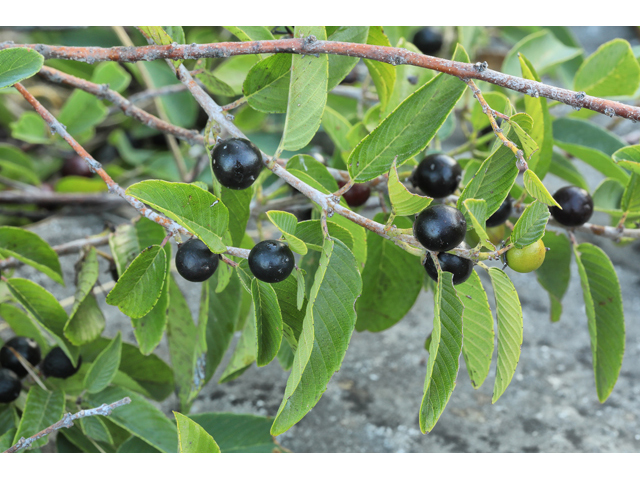
Native to the prairies, plains, meadows, pastures, and savannas of southern and western Texas as well as much of Mexico, this evergreen shrub or small tree is a member of the buckthorn family, Rhamnaceae, that also includes California lilac (Ceanothus spp.), and jujube tree. The Tarahumara, an indigenous people of Chihuahua, historically used the plant in medicines. They boiled the bark to make a tea to reduce fevers and tied leaves wrapped in cloth around their head to cure headaches. Another group indigenous to Mexico, the Tepehuán, ate the berries as a starvation food. Today, the plant is valued for its heat and drought tolerance and use as an ornamental in the garden especially in hot, dry areas. Photo Credit: Alan Cressler, wildflower.org
Description: The plant grows 1-20′ tall (more commonly 6′), is much branched, and has a spineless stem. The elliptical to oval, dark green leaves are 1-3″ long and have prominent veins and slightly recurving margins. From summer to fall, clusters of small greenish flowers with 5 petals appear in the leaf axils and give way to fleshy, berry-like fruits that are 1/2″ across, one-seeded, and dark red, brown, or black .
Poisonous Properties: The leaves and fruits, especially the seeds, are toxic to humans and livestock, including goats, sheep, cattle, hogs, and fowl, with cattle being most susceptible. Raccoon, coyote, and fox, however, appear to eat the berries and survive, perhaps because the seeds pass through their digestive system without being broken down. The berries/seed are much more toxic than the leaves but both contain compounds that can cause spasms and paralysis in the extremities, sometimes affect breathing or liver function, and ultimately can lead to death. The onset of symptoms may be days or even weeks after ingestion, sometimes making it difficult to diagnose the cause of the problem.